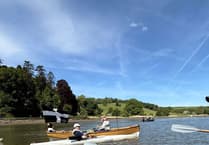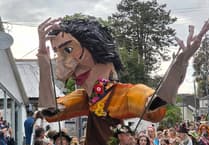The road was discovered halfway through an excavation by a team from city council-based Exeter Archaeology, who have returned to the site next to St Andrew's Church in Calstock where a Roman fort was found unexpectedly at the beginning of 2008.
The seven-week excavation is being funded by an English Heritage grant of £80,000 and is taking place in the unused area of the parish cemetery.
Dr Chris Smart, who discovered the fort last year and is back again, said there had been some significant finds over the past three weeks: 'In addition to further evidence of the construction of the fort and the range of buildings that were situated within it, the excavation has unearthed the first Roman road seen in Cornwall.
'The road would have connected the fort with sites further west and to the east where the road heads towards the river. It is likely that a crossing to Devon and a contemporary port remain to be found nearby.'
The discovery of possible early medieval pottery suggested activity there after the end of Roman control of the British Isles, added Dr Smart.
'At some point the fort's defences, consisting of a timber and earth rampart and two massive ditches, and enclosing an area of about two hectares, were replaced by a substantial stone wall.
'One of the key questions that we must now answer is when this enclosure wall was built, and why.'
The excavation has provided the opportunity for the public to gain a better understanding of their heritage, and visitors have been welcomed throughout.
In additions to events for local schoolchildren, a public open day is being held on Saturday (January 31) from 10am to 4pm.
English Heritage has funded the work in order that the 'fragile site' can be recorded before it is destroyed by the extension of the graveyard located inside it. It is only the third Roman fort that has been unearthed in Cornwall and is the largest of the three.
Dr Smart had been carrying out geophysical surveys to find remains of the royal silver industry of the late 13th and 14th centuries and said the unexpected discovery of the fort was an 'amazing bonus.'
A small excavation in a field to the south of the cemetery showed that the fort was constructed at the end of the first century AD and continued in use into the second century AD.
'It showed that the Roman army were working metals and it is hoped this latest work will shed further light on why the fort is located there and for how long it was occupied,' said Dr Smart.
'It cannot be down to chance that it is located at the navigable limit of the River Tamar within a rich mining district historically famous for the production of copper, tin, lead and silver.
'These are exciting times in Cornish archaeology and we expect that the picture of Roman occupation of Cornwall will expand in the coming years.'



